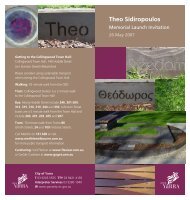Mix It Up Project Report: Building New Audiences - Multicultural Arts ...
Mix It Up Project Report: Building New Audiences - Multicultural Arts ...
Mix It Up Project Report: Building New Audiences - Multicultural Arts ...
Create successful ePaper yourself
Turn your PDF publications into a flip-book with our unique Google optimized e-Paper software.
Seven Strategies for Working in <strong>New</strong> Ways<br />
<strong>Mix</strong> <strong>It</strong> <strong>Up</strong> Research <strong>Project</strong> 2006<br />
- 26 -<br />
Centre For Leisure Management Research<br />
The complexity of <strong>Mix</strong> <strong>It</strong> <strong>Up</strong> wasn’t simply working with cultural diversity, it was also complex in<br />
terms of the number of artists from overseas, visas and tax issues and the logistics of it was<br />
much more complicated…and it was done within a narrow time-frame. (Administrator)<br />
This section gives an account of the interviews with stakeholders for <strong>Mix</strong> <strong>It</strong> <strong>Up</strong>. <strong>It</strong> is based on qualitative<br />
interviews with musicians, curators, administrators, consular officers, marketers and volunteers. Some of these<br />
people were, of course, also audience members. The purpose of the stakeholder interviews is two-fold. First, the<br />
results of the interviews describe how <strong>Mix</strong> <strong>It</strong> <strong>Up</strong> was formulated, implemented and evaluated. There are<br />
prescriptions of how multicultural projects should be designed and they are used as secondary source material.<br />
However, little is known of how such projects evolve in practice. These strategies fill this gap. Second, the<br />
responses and experiences of the stakeholders are recorded, especially in light of the assumptions and<br />
perceptions which arts professionals hold about multicultural arts projects. The interviews were conducted in<br />
order to see if there were any perception gaps between arts professionals and stakeholders and to examine the<br />
implications of formulating, implementing and evaluating multicultural arts projects.<br />
<strong>Mix</strong> <strong>It</strong> <strong>Up</strong> can be useful in stimulating discussion about how to develop multicultural arts programs, including<br />
developing new audiences and developing new product, as well as the benefits people gain from participating in<br />
the program. The seven strategies are:<br />
- achieve organisational and cultural change by appointing a change champion<br />
- build relationships between communities and <strong>Arts</strong> Centre key players<br />
- create dialogues with communities through curators and programmers<br />
- appoint cultural ambassadors as holders of the keys to the doors to multicultural communities<br />
- empower marketing staff to act as facilitators with community marketers<br />
- provide skills to artists to enable them to leverage new work from <strong>Arts</strong> Centre performances<br />
- establish multicultural peer networks<br />
The seven strategies were piloted in <strong>Mix</strong> <strong>It</strong> <strong>Up</strong> and are now discussed.<br />
1. Achieve organisational cultural change by appointing change champions for <strong>Mix</strong> <strong>It</strong> <strong>Up</strong>




